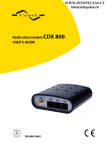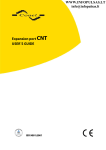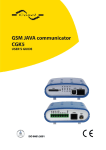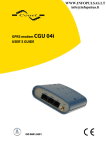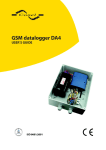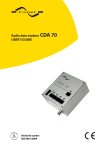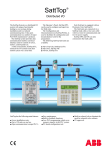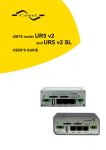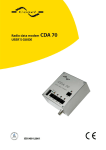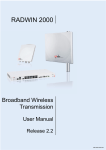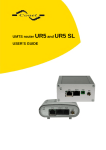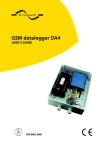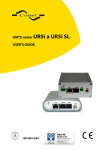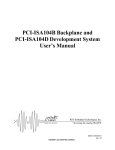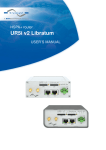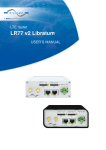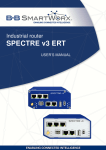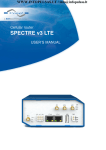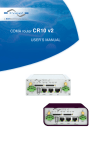Download Contents - Cru Power Oy
Transcript
CONTENTS Contents 1.Safety instructions...........................................................................................................................4 2.Description of the port expander CDE7 ..........................................................................................5 2.1.General....................................................................................................................................5 2.2.Examples of possible applications...........................................................................................5 2.3.Compatibility with other Conel company expanders................................................................5 2.4.Description of CD7 components..............................................................................................5 2.4.1.Control microprocessor....................................................................................................5 2.4.2.Solid hardware interface..................................................................................................6 2.4.3.Optional hardware interface.............................................................................................6 2.4.4.User interface protocols...................................................................................................6 2.5.Technical parameters...............................................................................................................7 2.6.Expander power supply...........................................................................................................8 2.7.Users interfaces (connectors)..................................................................................................8 2.7.1.PORT 1 and PORT 2 connectors for RS232 (stand also for PORT 3 - PORT 6)............9 2.7.2.Connection of PORT3 - PORT6 connectors for RS485G..............................................11 2.7.3.Connection of PORT3 - PORT6 connectors for MBUS..................................................12 2.7.4.Connection of power supply connector PWR................................................................13 2.7.5.Connection of connector ETH........................................................................................15 2.8.Technical parameters (PORT3 - PORT6)..............................................................................16 2.9.Module status indication........................................................................................................18 2.10. Measuring CDE7 signals....................................................................................................19 2.10.1.Measuring the supply voltage......................................................................................19 2.10.2.Measuring internal CDE7 temperature........................................................................19 2.11. Setting CDE7 parameters...................................................................................................19 2.11.1.Service cable ...............................................................................................................20 2.12. Standard accessories.........................................................................................................20 2.13. Additional accessories........................................................................................................21 2.14. Assembly procedure...........................................................................................................21 2.15. Mechanical external dimensions and mounting recommendations....................................22 2.16. Product marking..................................................................................................................25 2.17. PORT3 to PORT6 marking.................................................................................................25 2.18. CDE7 production label .......................................................................................................25 2.19. Production labels of interfaces PORT3 – PORT6...............................................................25 3.Expansion ports mounting.............................................................................................................26 4.Links to related products of the manufacturer...............................................................................28 4.1.Program.................................................................................................................................28 5.Reference......................................................................................................................................28 6.Product disposal instructions.........................................................................................................28 7.Complaints procedure...................................................................................................................29 8.Warranty........................................................................................................................................31 2 CONTENTS Symbols used Danger – important notice, which may have an influence on the user’s safety or the function of the device. Attention – notice on possible problems, which can arise to in specific cases. Information, notice – information, which contains useful advices or special interest. Conel s.r.o., Sokolska 71, 562 04 Usti nad Orlici, Czech Republic Issue in CZ, 02/07/2008 3 SAFETY INSTRUCTIONS 1. Safety instructions Please observe the following safety instructions: • The expander has to be used in accordance with all applicable international and national laws or any special regulations that may govern its use for particular applications and devices. • Use only the original Conel company accessories. Thus you will prevent possible health risks and damage to the devices and ensure compliance with all relevant provisions. Unauthorised adjustments or use of unapproved accessories may result in damage to the expander and breach of applicable laws. Use of unapproved adjustments or accessories may lead to cancellation of guarantee, which has no effects on your legal rights. • You are not allowed to open the expander. • Voltage on the expander supply connector shall not be exceeded. • Do not expose the expander to extreme conditions. Protect it from dust, moisture and heat. • It is recommended to create proper copy or backup of all the important settings saved in the device’s memory. 4 CDE 7 DESCRIPTION 2. Description of the port expander CDE7 2.1. General CDE7 is a data transmission device. Port expander is one elements of AGNES GPRS system. ARNEP protocol is implemented above the line layer. On its basis the modules create virtual private data network in where it can be transferred data between user devices via any protocols. One may simply imagine the CDE7 module as a protocol converter between the user interfaces (including Ethernet). In fact the device is much more complicated, as it provides the user with possibility to communicate simply between all the systems. Expander CDE7 is controlled by communication 32-bit microprocessor. It ensures, data transfer on serial user interfaces and a number of diagnostic and service features. CDE7 module in the basic version has six serial user interfaces. Two interfaces RS232 are solid, four user interfaces are optional (RS232, RS485, MBUS). Module CDE7 contains one Ethernet interface It is possible to set transfer parameters and communication protocol for each serial user interface separately. As a result you may communicate with various user interfaces using different communication protocols on serial interface. 2.2. Examples of possible applications • • • Router in AGNES network Converter of communicate interfaces Function expansion about other inputs 2.3. Compatibility with other Conel company expanders Regarding the communication and data transfers the CDE7 module is compatible with the older CDE6. This means it is possible to combine both types in one network and simply extend for example an existing network of CDE6 modules with new communication points using CDE7 modules. CDE7 provides some features not included in the older CDE6 type. 2.4. Description of CD7 components 2.4.1. Control microprocessor Thirty-two-bit microprocessor Freescale Coldfire with 128 Mbit SDRAM backup memory, 64 Mbit FLASH EEPROM memory and realtime circuit with reserve power supply makes for the basis of CDE7 control microprocessor. Software is based on realtime operating system that processes simultaneous tasks. Thus parallel operation of all external interfaces of the expander module is maintained. To microprocessor are connected two solid serial interfaces RS232, four optional serial interfaces and Ethernet 10/100 Mbps interface. In case other than RS232 interface device needs to be connected, e.g. RS485, it is possible to connect level converter to the serial port according to particular application. The microprocessor can control such external converter. 5 CDE 7 DESCRIPTION The microprocessor enables connection user devices through all interfaces at the same time. Ports are linked to RJ45 connectors marked PORT1 to PORT6 and ETH. All user interface signals are protected against overvoltage on the data cable. A device with different communication protocol can be connected to each interface. The microprocessor may work as a protocol converter between separate serial user interfaces. A wide scale of CDE7 module features can be configured through any user interface using service software [1]. The microprocessor further manages numerous functions of servicing, diagnostic and installation purposes. Data transfer statistics, separate serial port communications, power blackouts, voltage of the reserve supply, CDE7 temperature and some other important information – everything is recorded in the microprocessor’s memory. CDE7 settings are saved in FLASH EEPROM memory. Service SW RADWIN [1] is designed for CDE7 module configuration. 2.4.2. Solid hardware interface Interface RS232 is solidly adjusted on port 1 and 2 (PORT1 and PORT2). Ethernet interface belongs among solid hardware interfaces. 2.4.3. Optional hardware interface PORT3 – PORT6 on the CDE7 back panel provides for direct use of other HW interface than the standard RS232. It is due to the design of the interface as a separate module built inside CDE7. Thus you may use CDE7 module combined with other RS232 or with RS485, MBUS. 2.4.4. User interface protocols There are some industrial protocols implemented on the serial user interface: • ARNEP • AT modem • Linka-LINE • MODBUS • MODBUS-TCP • RDS92 CONEL • TCP-Port On the ethernet port are implemented protocols: • • • • • • • • TCP port – Linka TCP port – Arnep TCP port – RDS92 TCP port – AT modem TCP port – Modbus Agnep Net Modbus TCP-SL New protocols, not supported by the expander yet, can be implemented according to the customer’s needs. CDE7 module also enables the implementation of own user protocol directly by the customer. 6 CDE 7 DESCRIPTION 2.5. Technical parameters CDE 7 Complies with standards Power safety EMC Temperature range Function Storage Supply voltage (car dashboard) Consumption Dimensions Weight Assembly User interfaces PORT1- PORT2 PORT3 - PORT6 ETH 7 EN 60950-1:06 ed.2 ETSI EN 301 489-1 V1.6.1 -20 oC to +55 oC -40 oC to +85 oC +10 to +30 V DC 3,5 W 103 x 42 x 139 mm 350 g DIN 35 mm RS232 - connector RJ45 (300 b/s - 115 200 b/s) Connector RJ45 – possibility to configure discretionary interface through expanded modules,see above Ethernet 10/100 Mbps RJ45 connector CDE 7 DESCRIPTION 2.6. Expander power supply CDE7 needs DC power supply +10 – +30 V. The energy consumption is necessary for proper function to ensure peak current of 1,5 mA from the supply. 3,5 W. It is 2.7. Users interfaces (connectors) There are four connectors RJ45 (PORT3 to PORT6) located on the back panel. There is a possibility to configure the port's interfaces, see above. There are two RJ45 connectors (PORT1 and PORT2), interface RS232 and one RJ45 connector (Ethernet) located on the front panel. PWR connector is used for supply adapter connection. 8 CDE 7 DESCRIPTION 2.7.1. PORT 1 and PORT 2 connectors for RS232 (stand also for PORT 3 - PORT 6) Panel socket RJ45 (RS232 – DCE - Data Communication Equipment). Pin Signal number mark 1 2 3 4 5 6 7 8 RTS CTS DTR DSR GND RXD CD TXD Description Data flow direction Request To Send Clear To Send Data Terminal Ready Data Set Ready – connected to +4 V through 330 Ohm GROUND – signal ground Receive Data Carrier Detect Transmit Data Input Output Input Output Output Output Input Circuit example of the meter with expander CDE 7: Pin 1 – RTS Pin 2 – CTS Pin 3 – DTR Pin 4 – DSR Pin 5 – GND Pin 6 – RXD Pin 7 – CD Pin 8 – TXD Meter Expander CDE 7 Circuit example of the PC with expander CDE 7 (possibility to use the all RS232 ports): PWR ETH Expander CDE 7 PORT1 Cable KD-2 ● 9 PORT2 the cable KD2 is connected to the PC serial port (example. COM1) CDE 7 DESCRIPTION Circuit example of the expander CDE 7 to equipment with full-value RS232 interface (possibility to use the all RS232 ports): PWR Cable KD-2 ETH PORT1 PORT2 10 Expander CDE 7 CDE 7 DESCRIPTION 2.7.2. Connection of PORT3 - PORT6 connectors for RS485G Panel socket RJ45 Pin number 1 2 3 4 5 6 7 8 Signal mark GND GND TxRxTxRx+ TxRxTxRx+ +12V EXT +12V EXT Description Signal and supply ground Signal and supply ground RS485 B (-) RS485 A (+) RS485 B (-) RS485 A (+) External supply +12V External supply +12V Data flow direction Input/Output Input/Output Input/Output Input/Output Beware! External supply is just for moduls PORT3 to PORT6 – RS485G Example of port circuitry: Meter DC + 11 Pin 1 – SGND Pin 2 – SGND Pin 3 – RS485 (-) Pin 4 – RS485 (+) Pin 5 – RS485 (-) Pin 6 – RS485 (+) Pin 7 – +12V EXT Pin 8 – +12V EXT Expander CDE 7 CDE 7 DESCRIPTION 2.7.3. Connection of PORT3 - PORT6 connectors for MBUS Panel socket RJ45 Pin number 1 2 3 4 5 6 7 8 Signal mark SGND SGND TxRxTxRx+ TxRxTxRx+ +12V EXT +12V EXT Description Signal and supply ground Signal and supply ground MBUS B (-) MBUS A (+) MBUS B (-) MBUS A (+) External supply +12V External supply +12V Data flow direction Input/Output Input/Output Input/Output Input/Output Beware! External supply is just for MBUS. Example of circuitry: Meter DC + 12 Pin 1 – SGND Pin 2 – SGND Pin 3 – MBUS (-) Pin 4 – MBUS (+) Pin 5 – MBUS (-) Pin 6 – MBUS (+) Pin 7 – +12V EXT Pin 8 – +12V EXT Expander CDE 7 CDE 7 DESCRIPTION 2.7.4. Connection of power supply connector PWR Panel socket RJ12 Pin Signal number mark 1 2 3 4 5 6 +UN NC INAC +UN GND GND Description Data flow direction Positive pole of DC supply voltage (10 to 30 V) Not connected Network supply presence check. Range 0 – 38 V Positive pole of DC supply voltage (10 to 30 V) Negative pole of DC supply voltage Negative pole of DC supply voltage Input Note: Clamps 1-4 (+UN) and 5-6 (GND) are in the expander connect for bigger current overload. There is a possibility to use INAC (NAP230) signal on the power supply connector, for monitoring AC voltage presence for power supply (could be functional just in case accumulator power supply backup ) Beware – it is impossible to link 230 v supply voltage directly to input INAC (NAP230)! Example of circuitry: DC powered + DC Pin 1 – +UN Pin 2 – NC Pin 3 – INAC Pin 4 – +UN Pin 5 – GND Pin 6 – GND Expander CDE 7 DC powered with backup battery and with monitoring of power supply present + 13 Pin 1 – +UN Pin 2 – NC Pin 3 – INAC Pin 4 – +UN Pin 5 – GND Pin 6 – GND + DC Expander CDE 7 CDE 7 DESCRIPTION DC powered with backup battery without monitoring of power supply present + 14 + DC Pin 1 – +UN Pin 2 – NC Pin 3 – INAC Pin 4 – +UN Pin 5 – GND Pin 6 – GND Expander CDE 7 CDE 7 DESCRIPTION 2.7.5. Connection of connector ETH Panel soket RJ45. Pin Signal Meaning number mark 1 TXD+ Transmit Data – Positive pole 2 TXDTransmit Data – Negative pole 3 RXD+ Receive Data – Positive pole 4 DNC --5 DNC --6 RXDRecieve Data – Negative pole 7 DNC --8 DNC --ATTENTION! Port ETH is not POE (Power Over Ethernet) compatible! 15 CDE 7 DESCRIPTION 2.8. Technical parameters (PORT3 - PORT6) ● for product Expansion port MBUS Name of product Expansion port MBUS Power supply Voltage Supply power Operating temperature Storage temperature Emission Immunity Safety Max. devices (each 1,5 mA) Max. operating bus current Overcurrent detection Short circuit endurance Bus voltage mark Bus voltage space Max. total cable length (300Bd, 200nF/km) Environment Standards M-Bus specifications (EN 1434) 10,8 .. 15,6 V max. 30 W -20 .. +55 C -20 .. +85 C EN 55022/B ETS 300 342 EN 60950 30 60 mA 100 mA permanent 36 .. 43 V 24 .. 31 V 1000 m Information about short-circuit on wiring of bus M-BUS is possible to find out in VF statistics for port COM wickedly state of signal DTR. Level 1 indicates correct activity of the bus, level 0 informs about a short-circuit on the bus. ● for product Expansion port RS232 Name of product Expansion port RS232 Power supply Environment Internal Operating temperature Storage temperature Emission Immunity Safety Max. operating bus current Max. bit rate Max. overvoltage Max. total cable length (300Bd, 200nF/km) Standards RS232 specifications (EN 1434) 16 ... -20 .. +55 C -20 .. +85 C EN 55022/B ETS 300 342 EN 60950 15 mA 230400 bps ±30 V 20 m CDE 7 DESCRIPTION ● for product Expansion port RS485G Name of product Expansion port RS485G Power supply Voltage Supply power Operating temperature Storage temperature Emission Immunity Safety Isolation Max. devices (each 1,5 mA) Max. data rate Overcurrent detection Short circuit endurance Max. total cable length (300Bd, 200nF/km) Environment Standards Bus RS485 specification (EN 1434) 10,8 .. 15,6 V max. 30 W -20 .. +55 C -20 .. +85 C EN 55022/B ETS 300 342 EN 60950 EN 60747 256 38400 bps 250 mA permanent 1200 m External or internal PORT(3-6)-RS485G power supply could do with J2 and J3 connection. If is required external power supply, must be pins 2-3 linked through jumper J2 and jumper J3 must be open. Internal supply is made 1-2 pins connection on jumper J2 a jumper J3 connection. Jumper location is on the picture below. (module PORT-RS485G from TOP side). Jumper J3 Jumper J2 Module PORT(3-6)-RS485G from TOP side 17 CDE 7 DESCRIPTION 2.9. Module status indication Status indication is indicated through thirteen diodes (LED). The five diodes are situated on the front side and eight diods are on the back panel side. Green diode serves to indicate expander status and is marked by letter P (Power). The other diodes indicate the interface status (reception or data transmission). Communication through ETHERNET interface is indicated by two diodes, situated on ETHERNET connector. Colour Description GREEN P RED RED RED RED RED RED RED RED RED RED RED RED R1 T1 R2 T2 R3 T3 R4 T4 R5 T5 R6 T6 Meaning Flashes once a sec…………...proper function Lights permanently……….…...fault Off…………………………....….no DC supply, loading OS in progress Data receiveing on port 1 Data transmiting on port 1 Data receiveing on port 2 Data transmiting on port 2 Data receiveing on port 3 Data transmiting on port 3 Data receiveing on port 4 Data transmiting on port 4 Data receiveing on port 5 Data transmiting on port 5 Data receiveing on port 6 Data transmiting on port 6 Ethernet interface GREEN YELLOW 18 Lights ................................. communication 100Mbit/s Off …...................................communication 10Mbit/s Lights …............................ .proper interface connection Flashes ….......................... interface communication CDE 7 DESCRIPTION 2.10. Measuring CDE7 signals 2.10.1. Measuring the supply voltage Another three signals are measured in CDE7. The first is called NAP12 (DC SUPLY), it is an internal one and describes supply voltage on CDE7 brackets. The measuring range is 0 to 38 V. The supply voltage value has an effect over CDE7 function – in case the value is out of measuring range, is recorded in CDE7 statistics. The second one is internal and measures stabilized CDE7 supply voltage 3.3 V. The measuring range is 0 to 20 V. The supply voltage value has an effect over CDE7 function – in case the value is out of measuring range, is recorded in CDE7 statistics. The second one is NAP230 (AC SUPLY) linked to the supply connector (see the supply connector description). The measuring range is 0 to 38 V. The signal is protected against overvoltage by a protection element that blocks voltage in excess of 36 V. NAP230 is designed for measuring of network supply voltage presence. The change of the value is recorded in CDE7 statistics as a failure and rise of supply voltage 230 V. Current supply voltage values can be read from configuration program. Beware – it is impossible to link 230 V supply voltage directly to the input! 2.10.2. Signal name Measuring range [V] Resolution [bit] NAP12 3.3V NAP230 (INAC) 0 to 38 0 to 3.6 0 to 38 overvoltage 36 V blocked 10 10 10 Measuring internal CDE7 temperature To ascertain proper function, temperature is measured inside CDE7. In case the temperature is out of measuring range, is recorded in CDE7 statistics. Current temperature values can be read from configuration program. Signal name Measuring range [oC] Resolution [bit] TEP -40 to+120 10 2.11. Setting CDE7 parameters Configuration and service SW RADWIN is designed for the module setup. The software is created for MS WINDOWS 95/98/ME/2000/XP platforms. Service cable is designed for CDE7 with PC connection. After service cable (data cable KD-2 and jump service SEPRO) is connected to any serial user interface RS232 and service SW runs on a connected PC it is possible to 19 CDE 7 DESCRIPTION execute not just all the needed CDE7 settings, but service interventions in the data network as well. 2.11.1. Service cable CDE7 – PC connection cable with DCR and GND signals connected at 100 Ohm. It is made from normal data cable KD-2 by adding service interconnection SEPRO. It is necessary to interconnect all eight signals between CDE7 and PC. See RJ45 connectors’ description. Service cable Service interconnection SEPRO 2.12. Standard accessories 1. 2. 3. 4. 5. 6. 20 RJ12 supply connector for supply voltage cable. Three RJ45 connectors for data cables and CIO connection. Compliance certificate. Complaint procedure. Warranty. User manual CDE 7 DESCRIPTION 2.13. Additional accessories 1. Power supply 2. Expansion ports ● ● ● Expansion port RS232 Expansion port RS485G Expansion port MBUS 2.14. Assembly procedure DIN 35 mm rail assembly using plastic grips. 21 CDE 7 DESCRIPTION 2.15. Mechanical external dimensions and mounting recommendations For the majority of applications with a built-in modem in a switch board it is possible to recognize two sorts of environments : ● nopublic and industry environment of low voltage with high interference, ● public environment of low voltage without high interference. For both of these environments it is possible to mount modems to switch board, the following it is not need have no examination immunity or issues in connection with EMC according to EN 60439-1+A1. For compliance of EN 60439 - 1 + A1 specification it is necessary observe next assembly of the modem to the switch - board : ● for single cables we recommend to bind the bunch according to the following picture, for this use we recommend: • length of the bunch (combination of power supply and data cables) can be maximum 1,5 m, if length of data cables exceeds 1,5 m or in the event of, the cable leads towards the switch - board, we recommend to use fit over - voltage protectors (surge suppressors), • with data cables they mustn't carry cables with reticular tension ~ 230 V/50 Hz, • all signals to sensors must be twisted pairs. 22 CDE 7 DESCRIPTION 23 ● sufficient space must be left before individual connectors for handling of cables, ● for correct function of the modem we recommend to use in switch - board earth-bonding distribution frame for grounding of power supply of modem, data cables and antenna, CDE 7 DESCRIPTION ● 24 the circuit diagram of the modem is on the following pictures. CDE 7 DESCRIPTION 2.16. Product marking Trade Type marking marking CDE 7 CDE-7 Standard communicate interfaces 2 x RS 232, 1 x Ethernet Aditional interfaces RS232, RS485, MBUS Power supply +10 až +30 V DC 2.17. PORT3 to PORT6 marking Trade marking Type marking Supply Expansion port RS232 XC-232 Internal from module CDE 7 Expansion port RS485 XC-485 Internal from module CDE 7 Expansion port MBUS XC-MBUS External 10,8 .. 15,6 V Other Variation RS-485G demand external power supply 10,8-15,6 V 2.18. CDE7 production label 2.19. Production labels of interfaces PORT3 – PORT6 25 EXPANSION PORTS MOUNTING 3. Expansion ports mounting Attention! Expansion port include when the expander CDE 7 is switch off. After unscrewed four screws (position 11) on the front head (position 5) and remove the motherboard B-CDE-7 (position 7) the expansion port PORT3 - PORT6 (position 8) connect to expander B-CDE-7 motherboard (position 7) from both sides. Every expansion port is mounted to motherboard by the help of three distant columns (position 10). After expansion ports mounting, motherboard move and front head mount the box is screwed by the help four screws (position 11). Parts list and description Part Description Number 1 CDE 7 box top part 1 2 CDE 7 box bottom part 1 3 CDE 7 side profile 1 4 CDE 7 side profile 1 5 CDE 7 front head 1 6 CDE 7 rear head 1 7 B-CDE-7 motherboard 1 8 Expansion ports (RS232, RS485 and or MBUS) 9 CR2032 battery cell 10 Distance column for expansion ports mounting to motherboard 11 Screws for box completation 8 12 Double sided glue tape 2 26 up to 4 1 up to 12 EXPANSION PORTS MOUNTING 27 LINKS AND REFERENCE 4. Links to related products of the manufacturer Related products and materials with a reference can be found on the manufacturer’s website – Conel company: www.conel.cz 4.1. Program RADWIN – the software provides for creation, installation and administration of AGNES system GPRS data networks. 5. Reference [1] Conel s.r.o.: RADWIN Programme for control AGNES, 2008 6. Product disposal instructions The WEEE (Waste Electrical and Electronic Equipment: 2002/96/EC) directive has been introduced to ensure that electrical/electronic products are recycled using the best available recovery techniques to minimise the impact on the environment. This product contains high quality materials and components which can be recycled. At the end of it’s life this product MUST NOT be mixed with other commercial waste for disposal. Check with the terms and conditions of your supplier for disposal information. 28 COMPLAINTS PROCEDURE 7. Complaints procedure Dear customer, The product you have purchased had passed manufacturer’s tests and its functions had been checked by our technician before sale. In case any defect shows up during the guarantee period that prevents normal use we ask you to follow the Complaints procedure when registering your claim. To make a possible complaint procedure easier please make sure when taking over the product your vendor has duly filled in all the relevant parts of the warranty, including date, seal and signature. This complaints procedure relates to the purchased products. This complaints procedure does not relate to the services provided. Guarantee period of the products Guarantee period of 24 months from the date of purchase is provided for the device, source, antenna, data cable and possible accessories. The date of purchase is at the same time date of takeover. Registering a claim It is necessary to register your claim at the vendor where the subject of the complaint has been purchased. The customer shall present duly filled warranty and the complete subject of the complaint. Subject of the complaint shall be presented in a condition adequate to that at the moment of purchase. Caution! The vendor is not responsible for keeping default settings or data saved in the subject of the complaint. The customer is obliged to clarify the defect or how it is displayed and what claim he intends to register. Processing the complaint The vendor shall provide a free remedy depending on particular conditions, or replace the subject of the complaint for a new product, or settle the matter in another manner in compliance with the Civil Code and the Act on consumer’s protection. As of the moment the claim is registered by the customer and the subject of the complaint is taken over by the vendor the guarantee period stops running. The guarantee period continues on the date of takeover of the repaired subject of the complaint or replaced faultless product by the customer, or should it not be taken over on the date the customer is obliged to take over the repaired or replaced product. In case the vendor replaces the subject of the complaint for a new product (including IMEI replacement) the original subject of the complaint becomes property of the vendor and the new product becomes property of the purchaser. Since takeover of the new product a new guarantee period starts. In the cases when the vendor settles the matter after agreement with the customer by replacement of the subject of the complaint for a faultless product the new guarantee expires. 1. After 12 months since the replaced product was taken over by the customer. 2. On the date when the original guarantee period (subject of the complaint) would have expired should it not have been replaced, whichever comes first. 29 COMPLAINTS PROCEDURE 3. The claim is deemed unsubstantiated when the defect is not found by the vendor processing the complaint or the defect is not covered by the guarantee under Article 3 of the procedure. 4. In case the claimed defect is not found and functionality is proven to the customer, the customer is obliged to pay demonstrable cost related to expert assessment of the claimed defect. 5. In case defect is found when processing the complaint that is not covered by the guarantee (extra-warranty repair), the vendor shall inform the customer and the customer shall inform the vendor whether he/she wishes to have the defect repaired for the price set. A protocol shall be made on exact conditions of the extrawarranty repair and signed by both the customer and the vendor. Should the customer not require remedy through an extra-warranty repair under the conditions, the device shall be returned to him/her after he/she pays the demonstrable cost of expert assessment. The guarantee does not cover defects incurred due to 1. Mechanical damage (fall and the like). 2. Use of inadequate, or not recommended sources and other accessories. 3. Connection of the product with non-standard accessories. 4. Installation or use of the product conflicting with the Manual or use for other purposes than usual for this type. 5. Improper manipulation, or an intervention of unauthorised person or other service than authorised by the manufacturer. 6. Effects of natural forces (flood, fire etc.) or other local phenomena (storm, overvoltage and the like). 7. Storage under unauthorised temperatures. 8. Operation in a chemically aggressive environment. Other conditions The fact that the subject of the complaint does not conform to parameters set for other similar product types shall not be considered a fault. To assess whether it is a case of covered fault the parameters stated in the technical documentation for the product are decisive. The guarantee expires in any case of changes to the subject of the complaint, or damaged or otherwise unreadable serial number. 30 WARRANTY 8. Warranty Device type Serial number Guarantee period (months) Vendor Date of purchase Seal of the vendor 31 WARRANTY Date of complaint registration Complaint protocol number Date of reception of the device in repair shop Date of finished repair Number of repair sheet Warranty repair New serial number of the device (IMEI) Notes Seal of the repair shop 32 1 2 3 4 5 YES - NO YES - NO YES - NO YES - NO YES - NO
































